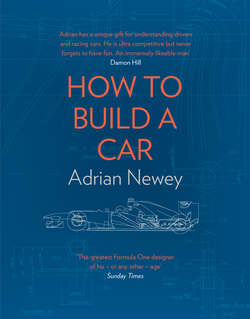Читать книгу How to Build a Car: The Autobiography of the World’s Greatest Formula 1 Designer - Adrian Newey, Adrian Newey - Страница 18
Turn Two
HOW TO BUILD A MARCH 86C
CHAPTER 16
ОглавлениеTruesport’s team principal was Steve Horne, a gruff Kiwi who liked to run a tight ship. That was fine, nothing wrong with that – up to a point. The trouble was, his style was very autocratic. For example, after qualifying at Indy, he decided that rather than continue with testing the following week leading up to the race, as is the norm, he would get the cars sent back to the race shop in Columbus for three days of prep back there. A questionable decision, but worse, the first thing Bobby and I knew of it was when we drove into the circuit on the Monday to see the Truesport truck heading out!
At the same time, Robin Herd brokered a deal for me to join Kraco, another March customer. On the table was an increased development budget, bigger salary and Michael Andretti, the talented son of Mario, as driver. I’d be moving there on the race-engineering side for 1986, while remaining as chief designer on the Indycar at March. What’s more, while Truesports was based in Columbus, Ohio, not the most exciting place to live, Kraco was in LA, which sounded a lot more appealing.
And so, after two years’ race engineering at Truesports, and having forged a wonderful relationship with Bobby, I decided to bid them a reluctant farewell and join Kraco for the race-engineering side of things.
I was still pulling double-duty, though, from July flying regularly back to the UK between races to begin research for the 86C.
Knowing that I would be in charge of design for the 1986 car allowed me to put in place a much more thorough wind tunnel and research programme than had been the case for the 1985 car’s rushed schedule. The chassis was quite a bit narrower and more elegant. But the big step forward was at the rear. By regulation, IndyCars have a single turbo, and it was a big unit. I had the idea of rotating it through 90 degrees, so instead of sitting across the car, it would sit longitudinally along the axis with the exhaust facing forwards rather than backwards. That way we could split the exhaust into two tailpipes, one to the left, one to the right, with each tailpipe looping around in a 180° bend, then transitioning into a fantail that could blow the back end of the diffuser.
We started developing that in the wind tunnel, using compressed air fed down through the mounting arm of the model, into the model and out through the exhaust, and it looked promising. I then redesigned the rear suspension completely to package it, which wasn’t easy because you now had a longitudinal turbocharger with the exhausts and waste gates all trying to vie for the same space with the rear suspension, particularly the spring/damper units.
We rearranged the rear dampers so they sat longitudinally beside the gearbox and above the exit from the exhaust. To prevent people from putting the exhausts into the diffuser – a practice that had become commonplace in Formula One during the 1984 season – IndyCar rules stated that the diffuser must not have holes in it. However, the spring/damper units would need a heat shield to prevent them from being burnt by the exhaust gas, so I positioned the units in such a way that the heat shield would be naturally tail up, creating a ‘coanda effect’ downforce-producing extension to the tailpipe. Not legal if considered part of the diffuser, but legal if considered as being there for the primary purpose of protecting the mechanical parts. This arrangement created a very high velocity/low pressure at the back of the main diffuser, drawing much more air through it. The overall package looked a powerful step forward in the tunnel.
Figure 6a: Technical drawing of the rear damper top of the March 86C.
Over the Atlantic was where I came up with the idea for the exhaust system and rear suspension. Not only that, but I very clearly remember sketching out the roll hoop layout on the plane.
The new roll hoop was made out of aluminium honeycomb instead of the traditional steel roll hoop, making it lighter and more aerodynamic, with a little titanium capping piece on top. It satisfied the regulations and I felt it was quite safe, because the problem with the steel roll hoop is that you’ve got four tubes going into a composite structure and you need to try to spread that load out so that the tubes don’t just punch a hole straight through the structure. It’s not easy and there have been plenty of instances where the roll hoop itself has stood an accident okay, but it’s punched straight through the chassis and therefore been pretty useless.
Figure 6b: Sketch of the split-exhaust and longitudinal turbocharger layout of the March 86C.
It turned out to be a bit controversial. One thing I hadn’t really taken into account was that if you went upside down on grass or in gravel, because it was a very pointed structure, it would just plough a furrow and therefore wouldn’t properly protect the driver in the way a more rounded hoop would. But we raced with it and, fortunately, there was no such accident.
Which brings me on to an important philosophical point – one that we all struggled with in those days.
